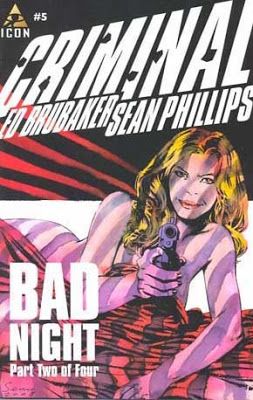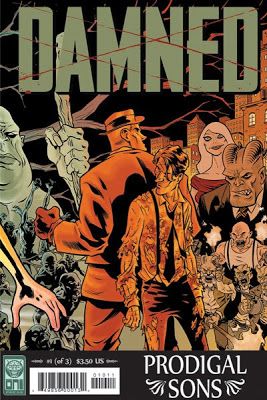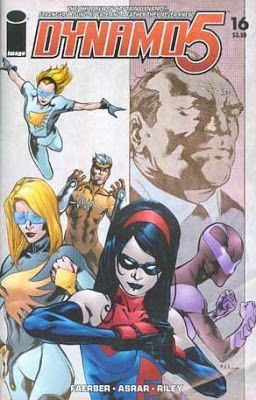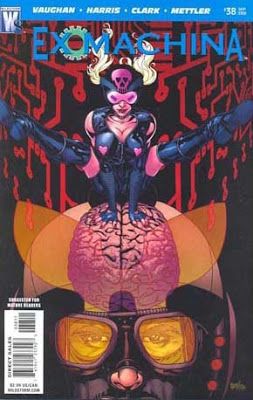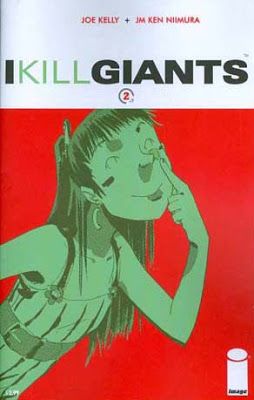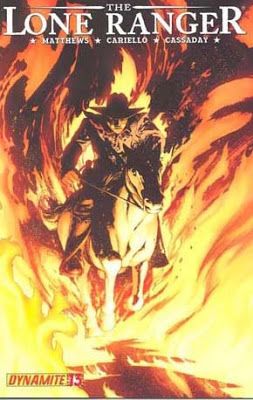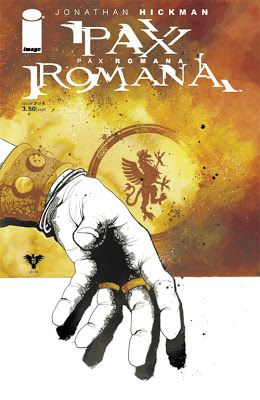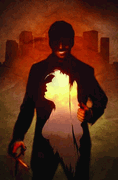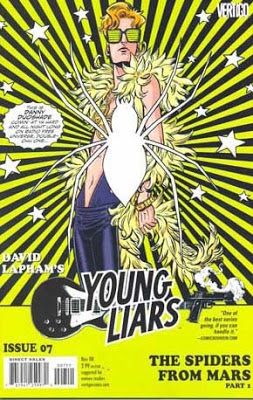This week: the most absolutely batshit insane comic book you will ever see. Seriously. And, thankfully, it comes at the end of the post, so we can lead up to it. Fear the revelations! Plus: Not one book from the mainstream DC and Marvel Universes! That's how indy I am, man!
(I'd like to point out that my scanner is still screwed up, so I don't have pictures of some of the covers this week, because I couldn't find them on-line. One day I will be able to control the scanning process once more! Ah, such a glorious day that shall be!)
Caliber: First Canon of Justice #5 (of 5) by Sam Sarkar (writer), Garrie Gastonny (artist), Imaginary Friends Studios (colorists), and Annie Parkhouse (letterer). $2.99, 26 pgs, FC, Radical Comics.
This final issue is much like the rest of the mini-series: An interesting premise (the Arthur story set in the Old West), nice if a bit slick artwork, and nuggets of goodness in a somewhat incoherent story. I thought about re-reading the first four issues before reading this, and maybe that will help the book hang together more, but like the previous issues, there are far too many panels that seem to come in random order in this issue. Sarkar is juggling a lot of balls, so he needs to zip back and forth between the characters, but it turns this into an action movie in which we are always catching up on the characters as they break off and fight their individual battles, and nothing feels like it's taking place at the same time or even place (you know the kind of movie I'm talking about!). Obviously, Sarkar has more on his mind than just an action movie, but it gets swept aside for a showdown with lots of blood, a hot redhead toting a rifle (there's nothing sexier than that!), an Asian whore in a slinky green dress pulling the needles out of her hair and stabbing people with them, locks flowing freely (whoops - I stand corrected!), and lots of people making vague, pseudo-important pronouncements. At the end, we just don't feel like the book has earned its somber ruminations on justice and the law. It wants to be deeper, but Sarkar can't resist a good shoot-out. Not that there's anything wrong with a good shoot-out, but when the book wants to be more, it gets in the way.
The premise is still interesting, and as the book ends with Arthur's ascendance, I wonder if another mini-series is planned. I certainly wouldn't say it's a complete failure as a comic, but it can get better, and I wonder if Sarkar, if he returns to this universe, will take his time a little more. That wouldn't hurt.
Criminal vol. 2 #5 by Ed Brubaker (writer), Sean Phillips (artist), and Val Staples (colorist). $3.50, 30 pgs, FC, Marvel/Icon.
There just isn't a lot to say about each individual issue of Criminal. I've written before, and I'll write again, about the way Brubaker and Phillips take the familiar concepts of noir and make them compelling, but that's also the reason I can't really love this book as much as many other people do (it was Chris Sims' best of the week, for instance, and yes, I can link to Sims as much as Curran can!). I mean, there are absolutely no surprises whatsoever in this issue. Does that mean I need surprises in order to be impressed? Of course not. But in this heightened and stylistic world that the book inhabits, it seems like no one has an independent thought. Iris, Danny, and Jacob act exactly the way we expect them to, and it's a credit to Brubaker that it doesn't feel forced. Even as I'm thinking, "Oh, Jacob, of course she's going to seduce you and try to turn you," and she does, it's kind of perversely satisfying to see that it's exactly what happens. It's a weird way to like a comic, especially because other books are predictable, too, and I can't stand it. Maybe it's the genre - there's something oddly voyueristic about watching these people destroy themselves utterly, and although we want to look away because we've seen it all before, we can't. We're like Milhouse: "I fear to watch, yet I can't turn away!" I like Criminal and think it's a worthy book (a lot of that has to do with Phillips, because his art here is spectacular), but I don't think it's as good as other people say.
Why do you, my good readers, like it so much? What about it draws you in? Let's work it out!
The Damned: Prodigal Sons #3 (of 3) by Cullen Bunn (writer) and Brian Hurtt (artist). $3.50, 30 pgs, BW, Oni Press.
See, here's another noir-ish kind of comic that, although it follows the "rules" of the genre and even ends the only way it can, keeps us on our toes because we're not quite sure what's going to happen next. The Damned has been delayed a while, which is a shame, because it continues to be a very entertaining book with great art. Eddie discovers a little bit about why he's able to come back from the dead, but, of course, not all of it, as that would spoil any surprises for the next mini-series! Meanwhile, his brother Morgan tries to revive him, and we find out something strange about him. The biggest problem with this series is that it feels like a placeholder for the next series, whereas the first series was more self-contained. If Bunn and Hurtt make sure there's another mini-series, I don't have a problem with that, but if for some reason another series is not forthcoming, this becomes an annoying tease. As I mentioned, it's still entertaining, but there's so much cryptic talk about events to come that I wonder if it should have been an issue longer so that the story could be more developed and the vague prophecies wouldn't be as obvious.
But it's always excellent to see Hurtt's art, so there's that!
Dynamo 5 #16 by Jay Faerber (writer), Mahmud A. Asrar (artist), Ron Riley (colorist), and Charles Pritchett (letterer). $3.50, 21 pgs, FC, Image.
Here's another comic I often have trouble reviewing. Unless something monumental occurs, there's not much to say except what I always say: This is a fantastic superhero comic, better than pretty much every other superhero comic out there right now. It has excellent, Bryan-Hitch-before-he-became-a-prima-donna art, a compelling main story, plenty of dramatic undercurrents, subplots galore, humor, and a sexy goth chick! Who doesn't love sexy goth chicks? Faerber even manages to throw in some clever social commentary while he's at it! Who doesn't love clever social commentary?
I don't know why you wouldn't love this comic. Is it the $3.50 price tag? Really? You'll pay four bucks for a convoluted and inexplicable alien invasion, but not $3.50 for excellent superhero adventure? Sheesh. You get the comics you deserve, people!
Ex Machina #38 by Brian K. Vaughan (writer), Tony Harris (penciller), Jim Clark (inker), JD Mettler (colorist), and Jared K. Fletcher (letterer). $2.99, 22 pgs, FC, DC/Wildstorm.
Much like Dynamo 5 and Criminal, I find it often difficult to write anything cogent about Ex Machina, because at this point, there's not much point in writing about it. We know it's going to end at issue #50, and Vaughan and Harris will take their own sweet time getting to that point (the last issue came out, what, three months ago?). If you're not on board yet, you're probably not going to get on board. And each issue is kind of the same - constructed very well, nice-looking, with good character development and forward movement of the plot. The only issue I have with this particular issue is on page 4, when Monica throws coffee at Mitchell. The drawing makes it appear she throws it backhand at him, but what's still in her hand? And why is her hand and arm at such an awkward manner? I assume Harris uses photo-reference to draw, but whoever posed for this picture didn't do a very good job. Other than that, this is a typical issue of Ex Machina.
And that's good.
Freedom Formula #2 (of 5) by Edmund Shern (writer), Kai (artist), Jennyson Rosero (artist), Yina Goh (colorist), and Stanley Ong (letterer).
The second Radical comic I read this week is this one, and after a strong first issue, the second continues to be an interesting if fairly standard sci-fi book, but the switch in artist weakens it slightly, as it doesn't look quite as slick as the first issue. On some books, this is a detriment (like on Caliber, see above), but it worked on this one, because of the futuristic setting. It's not bad art in this issue by any means, but it seems off a bit. Plus, the murky coloring means that occasionally it's difficult to tell what's going on. It's frustrating.
The story is in flux, as we've established this world and the fact that racing has replaced war, and Zee, as the outsider and our surrogate, slowly gains access to what's going on in the city. There are a lot of machinations going on, both at the highest levels and down in the ghetto. In action-adventure comics like this, it's often obvious what's going to happen, and so it is with the ending of this issue, where the cliffhanger isn't as powerful because we knew it had to happen eventually. Even if it's obvious, that doesn't mean the comic is necessarily a failure - it's entertaining, after all, and as we go into the book knowing certain things will hold because of the nature of the genre, we don't mind as much. Well, at least I don't.
The first issue was a bit better because it established a more "wasteland" kind of feel to the book. Now that Zee has arrived in the city (Los Petropolis, if you must know), it seems to have settled in a bit and gone a different way. If you like science fiction, this isn't a bad comic to check out. It doesn't blow me away, but it's not bad, either.
Hercules: The Thracian Wars #5 (of 5) by Steve Moore (writer), Admira Wijaya (artist), Imaginary Friends Studios (colorist), Sixth Creation (colorists), and Todd Klein (letterer).
The best of the early Radical offerings comes to an end, as Hercules and his motley band take revenge on Cotys and his Thracian warriors. And yes, that's pretty much it. Sure, there's the resolution of the subplot with the Thracian rebel, but when he first showed up, it was obvious how that would end, so it becomes Fortinbras showing up at the end of Hamlet - he's a plot device to make sure that things don't end in complete chaos. (Fortinbras is an interesting character, because Shakespeare put him in the play simply to do that - in Elizabethan times, a play could not end with every member of the ruling family dead, because then the country would have collapsed. Queen Elizabeth would not have been pleased with this, so Shakespeare was forced to tack on a rather lame ending in which Fortinbras restored order and ensured that Denmark would be ruled by a strong leader. This is why most modern stagings of the play simply omit Fortinbras, because he's a symbol of an antiquated notion. Modern audiences just don't care if Denmark has a ruler after everyone dies or not. That's right, people - Shakespearean insights, only at Comics Should Be Good!) Other than that, this is just what it's supposed to be - warriors slaughtering other warriors. Perhaps because it doesn't pretend to be anything else, this is a far more enjoyable comic than Caliber. That book spends too much time trying to be high-brow, and it doesn't quite pull it off. Moore doesn't care about that - he wants to show Greeks bashing heads, and by God he's going to do it! It is, surprisingly, more subtle than Caliber about making its points - Hercules loves violence, but not indiscriminate violence, and he doesn't think oppressing the people is all that good an idea. He just wants to kill, get paid, and drink and fuck until he runs out of money and has to kill again. And what's wrong with that?
This isn't a great comic, but it's highly entertaining. Wijaya is up to the task of drawing lots of viscera, and the story just rollicks along. Come on - what would you rather read: A "controversial" comic about homeless mutants or a book where Hercules makes a sex joke over the body of a woman he's just killed? The choice is clear!
I do want to thank Radical for sending the three comics to me. I appreciate it.
I Kill Giants #2 (of 7) by Joe Kelly (writer) and JM Ken Niimura (artist). $2.99, 25 pgs, BW, Image.
In issue #2, this series takes a bit of a dark turn, as Barbara is haunted by mysterious voices calling her name and she tries to discourage a girl from befriending her, because people who get too close to her end up dead. Barbara might be melodramatic, but it's a creepy little scene. She also tells us about various giants, which is always nice, and explains to her new "friend" why her "war hammer" is called Coveleski - I'm such a sports geek I immediately thought it was named after Stan Coveleski and was pleasantly surprised to find Barbara named it after Stan's brother, Harry. That's the part of the book I like. I'm still on the fence about the parts of Barbara at school, because it seems so weird. As I mentioned with regard to last issue, I have become less impressed with stereotypical depictions of authority figures in school, because I was an authority figure at a school and I didn't see many people fitting the common stereotypes. I don't mind the school psychologist being a bit clueless, especially because Kelly does an interesting thing and makes sure that Barbara is wildly unsympathetic in the scene. But the other thing that puzzles me about the school scene is the bully, Taylor. Barbara is in fifth grade, which means she's 11 (give or take). I know that Taylor is unrealistically huge for effect, but she still looks out of place in an elementary school. Barbara can't be in middle school yet, because there's a reason why teenagers are separated from younger kids (and this is it), and fifth-graders wouldn't be in school with anyone over sixth grade. I take my daughter to elementary school every day, and I have never seen anyone as big as Taylor is. Again, I get that I shouldn't take her size seriously, and the point is that she's a bully, but I think that's a mistake on Kelly and Niimura's part. The "realistic" parts of Barbara's life should be as realistic as possible, because the giant-killing part is so fantastic. Taylor's presence (and Principal Marx's haircut, to use a different example) makes the school scenes less effective and makes the contrast between it and Barbara's "profession" less pronounced.
Still, it's a neat comic. The art is very cool, and Kelly is doing a good job, for the most part. I'm curious to see where he's going with it.
The Lone Ranger #13 by Brett Matthews (writer), Sergio Cariello (artist), Marcelo Pinto (colorist), and Simon Bowland (letterer). $3.50, 22 pgs, FC, Dynamite Entertainment.
Here's yet another book that's tough to discuss. It's not too long since issue #12, which is nice, but as usual, Matthews and Cariello set up a story and just let our brooding heroes brood through it. They rescue folk from a fire, Matthews makes some interesting points about Indians in the Old West, Cavendish is being all evil, and everyone broods some more. It's fascinating that, in a book that is fairly mass-market (Dynamite is a presence all over the place, whether or not their books sell well), Matthews chooses to go so olde-skool with this, meaning there is, as I may have mentioned, a lot of brooding. These men are not given to vocal introspection, nor is this book given to wild action. Sure, there's some action and some tense moments, but Matthews has successfully captured the mood of the great Westerns of yore. In a 22-page comic, that's pretty impressive. Cariello is an inspired partner in crime, making sure that faces tell us everyone we need to know about what's going in the heads of our tough-guy characters.
If you've ever liked Westerns, you should check this out. It's quite good.
Pax Romana #3 (of 4) by Jonathan Hickman (writer/artist). $3.50, 28 pgs, FC, Image.
I can't even remember when issue #2 of this comic came out, so I'm not sure if I have much to say about it until issue #4 comes out and I can assess the entire book. I must say that I think Hickman's art, which has its detractors, is fantastic, and I love the fact that he writes stuff that brings up difficult ideas, like enforced revolution to transform the Roman Empire into an Eternal Republic. A lot of people have expressed annoyance with Hickman's use of full pages of nothing but text, possibly because the conversations on them tend toward the pedantic, but this kind of blending of prose and art is what makes his books so interesting. There is, of course, trouble in paradise, but I'll get into that next time. I hope the next issue comes out soon!
The Straw Men #2 (of 12) by Joe Brusha (adapter) and Brett Weldele (artist). $2.99, 22 pgs, FC, Zenoscope.
It's only the second issue of this comic, so if you missed the first one, you can probably still get both! Do you really want to miss your chance to check out Weldele's art? I didn't think so!
In the first issue, we saw two seemingly divergent stories emerge, one about a man whose parents die but events cause him to doubt their deaths, and the second about a serial killer. They don't converge in this issue, but we get a bit more information about both storylines. Ward learns nothing about his parents, but we learn that someone is watching him and is worried that he's asking questions. Meanwhile, an FBI agent visits a dude in Vermont and tells him about the latest victim of the serial killer (who may be still alive) and the hair he used to stitch the victim's name on a shirt that he then sent to the cops (yes, it's twisted - he's a serial killer!). It's a terrifying comic, because even though most of it takes place in a park in Los Angeles, the killer is so casual and creepy as he explains to the victim how he's going to take her that we can't help but shudder. It's a nice move, setting the abduction there, because we don't expect it to be so scary. But it is.
Then, hilariously, there's an ad for Beyond Wonderland, another Zenoscope book, with a J. Scott Campbell cheesecake cover. It doesn't fit, but I guess Zenoscope has stuff to sell, if you're into grown-up hot chicks dressing like little girls!
Young Liars #7 by David Lapham (writer/artist), Lee Loughridge (colorist), and Jared K. Fletcher (letterer). $2.99, 22 pgs, FC, DC/Vertigo.
And then there's Young Liars. If you have not read an issue yet, or if you read the first one and decided it wasn't for you, I urge you to read this. Even if you don't buy it (if your local proprietor allows that), you should read it. You will not read a more fucked-up comic book this year. I honestly don't even know what the hell is going on in this issue. The pull quote on the front says it's "one of the best series going, if you can handle it," and although I'm vaguely insulted by that quote (it suggests that if you don't like it, you don't get it, which is a particular bugbear with me, as some of you may recall), in the case of this issue, it might be accurate. I don't know if I can handle this. It's that bizarre. Seriously.
What do I mean? Well, first of all, it has no relation to the first six issues beyond starring a character called "Sadie." It may eventually tie into the rest of the book, but right now, it stands alone (well, it's part one of two, so it stands as a beginning, but as part two isn't out yet, it stands alone for now). Then, on the first page, we see Sadie in her house, tapping her fingers on the dinner table and looking off-panel at something that's annoying her. Okay, so far, so good. But in front of her, upside down on a plate, is a gigantic fly. Yes, an insect the size of a small dog is her dinner. On the next page, we see what's annoying her - her mother is bent over the table while a man fucks her from behind. Her mother says, "Sadie, must you whine while I'm copulating?" And it only gets weirder from there.
By the time we're done, Sadie has sucked juice from that fly, shoved the straw into her mother's lover's eye, fled Mars (which is where she is) for Earth in front of an invasion of Martian spiders (hence the Bowie reference in the title of the story), switched bodies, shot up a bunch of other Martian spiders who have stolen bodies, and wreaked havoc. And I didn't even mention Danny Duoshade!
I honestly have no idea what to make of this. Lapham gives us no indication that this is a dream sequence (although maybe that's coming next issue), and it bears no resemblance to the earlier issues. It's disgusting, twisted, funny, violent, and insane. It features a woman eating someone's family jewels while griping about how difficult it is to get laid. It features child abuse, and makes it funny (in a horrific way, sure, but still). It's in bad taste, but unlike the movie of that name, I enjoy it, at least in the context of the comic. Am I a bad person?
Seriously, check this out. I can't guarantee you'll like it, but I can say with a great deal of confidence that you haven't read a comic like this in a long time, if ever. And as always with this comic, I'll be back next time, because I'm riveted by whatever the hell Lapham is doing.
So there are the comics from this week. For this week's totally random lyrics, I give you:
"I kicked up the dirt, and I said to my neighbor,
'We keep making it worse, we keep getting it wrong.'
He tucked in his shirt, he stood a little bit straighter,
He said, 'We need a few less words, dear, we need a few more guns.' "
Ponder those while you decide whether you want to buy Young Liars and have your mind blown. It's fun for the whole family!


